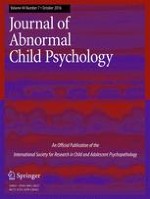22-12-2015
A FISTful of Emotion: Individual Differences in Trait Anxiety and Cognitive-Affective Flexibility During Preadolescence
Gepubliceerd in: Research on Child and Adolescent Psychopathology | Uitgave 7/2016
Log in om toegang te krijgenAbstract
Cognitive-affective flexibility represents the ability to switch between alternative ways of processing emotional stimuli according to situational demands and individual goals. Although reduced flexibility has been implicated as a mechanism for the development of anxiety, there is very limited data on this relationship in children and adolescents. The aim of the current study was to investigate cognitive-affective flexibility in preadolescents (N = 112, 50 girls, 11–12 and 13–14 years old) and to examine if this ability is related to individual differences in trait anxiety. Their interplay was assessed using the modified version of the Flexible Item Selection Task (FIST; Jacques and Zelazo 2001) with non-emotional stimuli (geometrical shapes) and the Emotional FIST (EM-FIST) with emotional stimuli (emotional facial expressions). Performance on the EM-FIST indicated that across the whole age range, trials requiring greater cognitive flexibility were more demanding than nonflexible ones, as revealed by both response time and accuracy performance. Moreover, flexibility demands were higher for younger children than for older ones but only in terms of response speed. Individual differences in trait anxiety moderated the impact of flexibility only on the EM-FIST. Being flexible on the EM-FIST was more demanding for high trait anxious children than for their low trait anxious peers. Lastly, overall girls responded faster than boys, but only in the EM-FIST. These findings extend the presently limited literature concerning variability in cognitive-affective flexibility during this sensitive developmental window.
